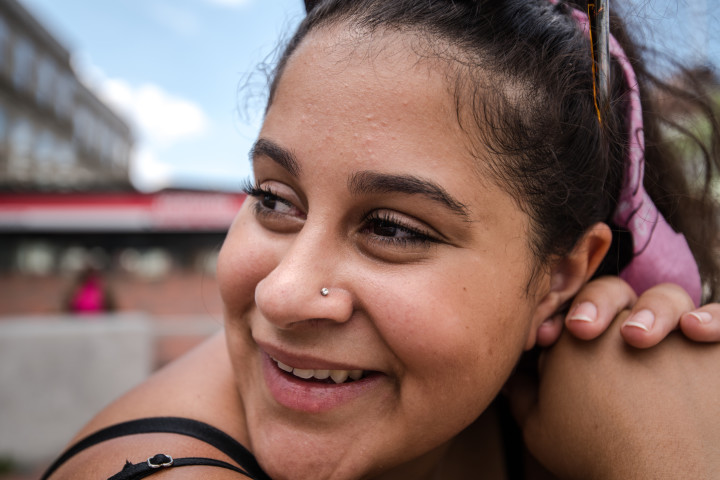How To Love Yourself When You’re Hurting

The Hurt: Several years ago, a blindsiding betrayal left me feeling utterly devastated. I felt alone, empty and more depressed than I ever had in my life. I felt utterly worthless, and on top of that, I felt ashamed for feeling worthless. I felt empty like nothing could ever fill the void within. I felt like nothing mattered. I was so sick and tired of feeling so sick and tired that I begged and prayed for the pain to just go away. I wanted to push it deep down within me. I wanted to numb it out. I wanted to just pretend like everything was ok. I filled my downtime with things that I thought would make me happy. I filled my downtime with things that I thought would make me happy, distracting from the pain and sorrow that I felt daily; ultimately ignoring my real needs along the way. For some time, I was lost, bitter and worse than all, angry. I couldn’t seem to figure out how to fill myself up with light and positivity. I was stuck in the dark abyss of devastation, betrayal and loss. The self-love and care that I had been practicing for years was a distant memory . . . One Day At A Time: Through my personal journey and recovery from addiction I gained many valuable lessons, but none more important than ONE DAY AT A TIME. In the depths of my self-destruction and hate, this lesson came to me again. I went back to what previously saved me, both personally and professionally, and began living my life with the simple motto and premise of ONE DAY AT A TIME. Meetings make it. I started attending more meetings, spent more time on the phone with my sponsor and began to pray. God has always been a part of my life but living each day the way I should meant God became a critical part of each day through prayer and meditation. Little by little, one slow day at a time, I began to open up to the knowledge that no one else was going to get me out of my pain. I had to start showing up for myself. The Change: I began my positive journey forward by first taking care of my body. I started to eat more, to sleep when I felt tired, to get out into the fresh air. Then almost in response, I started to take care of my mind. The negative self-talk; “you’re not worth it” was met with a challenge; “you are!”. I saw that my negative self-perception was stemming from false beliefs, false beliefs that formed out of my pain and sorrow. The truth then began to unfold. We have the ability to define our own happiness. We deserve a partner who won\’t bail without warning when the times get tough. We deserve to be loved truly. We deserve to be respected and valued. We deserve transparency and honesty. I began to fill myself back up, my self-love was no longer a distant memory. Whenever the waves of pain came on I cried and held myself, without shame or guilt. I was longing for love but rather than searching for it in things or people, I began to give it to myself. Nothing Worth Having Comes Easy Loving yourself isn’t always rainbows and butterflies. Some days I sunk back into a depressed state where I forgot who I really was and what I was really capable of. And then I woke up and remembered that I must be there for myself, as well as those closest and dearest to me. I found that ultimately I felt abandoned, so I swore to never abandon myself. You don’t choose yourself once and then it’s over. You must continue to show up for yourself in every moment, the difficult ones and the easy ones, one day at a time. Self-love means taking care of you. It is honoring and respecting you. It is having the courage to face your emotions, dig deeply but doing so with gentle care. Learning to love yourself doesn’t mean you never feel bad again. It doesn’t mean that you won’t feel pain anymore. This is constant and continuous work that has the ability to heal. It’s the bravest, most important work one can do for them self.
The Quest For Change

change /Chānj/ verb: make or become different noun: the act or instance of making or becoming different. Change, transformation, alteration … however one may choose to name it, can be seen all around us. Whether this change be taking public transportation rather than an Uber, making healthier lifestyle choices, or deciding to be a little more friendly to that colleague at work; more often than not we all have personal behaviors we wish we could adjust, stop, or start. From a young age we are introduced to change, some more often than others, and somewhere along the line we begin to form our own perceptions on the subject. Change: The mere mention of this word may cause some to feel uneasy. We often find ourselves resisting change, perhaps because of the perceived risk or fear associated with it. This resistance can be seen in the student who always finds himself or herself procrastinating, the ten-year smoker who keeps having one more, or the overly stressed boss who continues to add to his plate. It’s an interesting predicament we put ourselves in. So why do we have such a hard time initiating or following through with our desire to change? A renowned psychologist, James Prochaska proposed that we often find ourselves in the previously described predicaments as a result of our perception of change. Behavioral change is rarely a discrete or single event; however, we tend to view it in such a way. More often than not behavioral change occurs gradually, over time. The Transtheoretical Model of Behavior Change, created by Prochaska, identifies the various stages through which individuals move when attempting to adjust old habits or form new behaviors. A linear progression through the stages is not the norm. Individuals tend to move back and forth through the stages, re-cycling through them until the change becomes fully established. Why we have such a difficult time following through with desired change may perhaps be better understood through an exploration of Prochaska’s stages of change. As we come to gain knowledge behind the meaning and function of each stage we may gain a further understanding of where we stand in regards to our own progress. By identifying where we are in the process we can then shape and guide our goals to assist us in moving from one stage to the next. As you read through the following stages of change, I encourage you to consider what stage you may be in and what actions you might take to progress to the next.
Change, It Can be a Struggle – Here’s How to Make it Happen.

We all say we have something we want to change in our lives… “become a better person” “lead a healthier life” “repair relationships” “limit the amount of times I hit the snooze button” But, it’s one thing to want change and another to actually change. Every year, I make a verbal commitment to do something different. I genuinely want the change. But… alas I fail. Why?!? Why do we struggle with change? Throughout our lives, starting in childhood, we learn behaviors and skills that we use to get our personal needs met. These behaviors become habitual and automatic responses. Once we begin to sense that the behavior or thought is no longer working for us; whether on our own or through the suggestions of others, we start thinking about change. For example, if we learned in childhood that sharing our feelings and thoughts can make others upset and/or created feelings of fear due to someone(s) response – we may have realized that hiding our true thoughts and feelings could allow us to avoid conflict, judgment, and potential rejection. More on How to Overcome Situations Despite the initial pleasant outcome that can come from avoiding these consequences, low self worth and feeling “less than” can ultimately result from not feeling that one’s own feelings, thoughts, and needs are important to others. It often only increases your own fear of what people would think if they knew what was really going on inside you. This fear keeps us using the same behavior of hiding our true selves for a very long time. As we begin to sense that our needs aren’t being met or potentially when others point out that behaviors are causing us problems, we decide that we need to do something different. Problems may include issues in our relationships, jobs, maybe even substance use. At this point, we realize that we want a change that will increase positive outcomes such as feeling understood, feeling trusted, healthy relationships and reduced financial and legal issues. But, change is hard… And, every time we try to change and fail to maintain the change, our self-worth can be affected. We may tell ourselves, things like I just can’t do anything right. After several failures to change the same behavior, we may lose hope that the change is even possible for us. Recognizing that these “failures” have a positive lesson to be learned and if utilized are one step closer to creating long lasting change. Are You Trying to Quit Using Drugs or Alcohol? We offer an array of addiction treatment services & therapies What’s the Key to Change? A key to change is having a good plan. Many times people skip the planning stage and go straight to trying to change. But, as the saying goes… if you fail to plan, you plan to fail. Failing or relapsing to old behaviors is more likely to happen if you aren’t prepared for potential setbacks or triggers. A good plan takes into account how to cope with the potential negative consequences of the change, as well as how we will meet our needs that will no longer be met by the old behavior. Using the example above concerning hiding one’s true feelings and thoughts, not allowing someone to know your thoughts and feelings does in fact reduce the potential negative consequence for the person to judge you and can indeed decrease the anxiety that results from the fear of judgment. However, a good plan would account for how one will tolerate the potential anxiety in a positive way as well as how to manage hurt feelings if the person they share with does indeed judge them. Most, if not all, behaviors have some sort of either real or perceived positive consequences along with the negative consequences. If the current behavior wasn’t meeting at least some real or perceived need for us, we would have changed long before the moment we decide to change. For example, although drugs and alcohol have numerous negative consequences, many people continue to use substances as a coping skill to negative situations in the moment. Someone may abuse heroin to have a sense of relief from extreme anxiety. Although they may in fact reduce anxiety in the moment, the use of heroin can cause extreme negative consequences such as legal, financial, and relational issues that continue long past the use of heroin. There is a short term gain despite long term negative consequences. If there wasn’t a short term gain, people wouldn’t continue to use substances as a coping skill. How do I plan for change? Ready, Set, Go! Once a specific and individual plan has been formulated and the person takes the first steps, change begins to occur. The change requires consistent use and re-working of the plan as needed. For example, although someone who is hoping to change/ stop their use of substances may have a current plan that involves attending daily support group meetings after treatment, it is possible that their work, family, and other outside obligations may require the reduction of these meetings to three times per week. The plan would need to reflect this change. The individual would be wise to look at what need the support group attendance was meeting. Care and support to keep him/her feeling grounded for the rest of the day? Maybe he/she replaces the missed meetings by utilizing their breaks at work to call their sponsor and practice 5 minutes of deep breathing/meditation. Although relapses may occur, this does not mean the person should give up. ALL that it means is that the plan needs to be re-worked to include the new wisdom. Once the person seeking change is able to successfully avoid returning to the old behavior, the goal is to maintain the change. Just because someone has been successful at not returning to an old behavior, it does not mean that they do not have thoughts of returning to the old behavior. People in maintenance must remain mindful and





